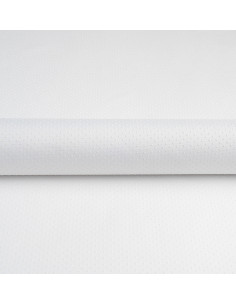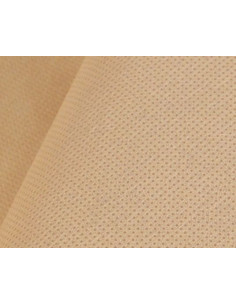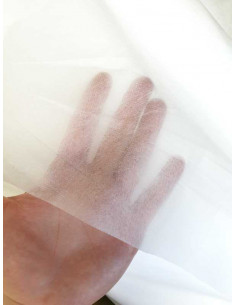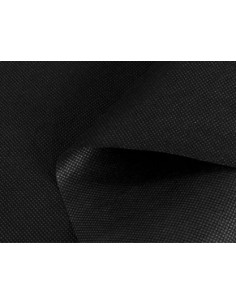Vigofil, otherwise known as upholstery interlining, is a non-woven polypropylene fabric that is characterized by high quality, as well as high fire resistance. It is a material produced by using Spunbond technology. Thus, upholstery interlining is a type of nonwoven fabric produced by direct molding of individual threads from polymer granules, and a combination of polypropylene and polyethylene. The complex manufacturing procedure results in a high level of strength, as well as an even tension of the individual threads. Their production does not generate high costs, however, they are characterized by good quality. The fibers retain their properties for a long time.
The indisputable advantage of interlining is that it is characterized by a high level of elasticity, while being resistant to stretching, tearing, abrasion, as well as high temperatures, or as already mentioned - it has high fire resistance. In addition, despite the tight weave of the individual fibers, it is perfectly permeable to air, so it can also be used as an interlining for tailors and in manufacturing of various specifications.
Fleece on meters - application in various industries
Fleece or interlining is a material used in the furniture industry in the broadest sense. Fleece is also used as a non-slip layer between upholstery foam, oat, and upholstery fabric (such as upholstery velour), making it significantly easier to apply the cover. The smooth texture of this material also allows it to be used as a raw material for seat upholstery or the top cover of pillows, bolsters or quilts. In the furniture industry, interlining covers elements that should not be visible, such as the back of a soda or the base of an armchair from the outside.
Tailor 's interlining is also used in the production of various types of bags (mainly in the form of reusable eco bags), advertising bags or covers of all kinds, as well as being an excellent packaging material, it also accepts pigment very well during dyeing. The edges of this fabric do not fray, so it is also used as a hem (the so-called trim), and in bags it is added as a durable lining, which is an alternative to the classic textile lining. It is also used as a stiffening or reinforcing material, especially in the thicker version, as it is resistant to tearing or stretching.
How to choose interlining, or a few words about grammage
Fleece is also often referred to by names such as wigofil, wigolin, agrowoven (that is, interlining used in horticulture). Sometimes we may wonder whether we should use the name interlining or fleece - however, we can use these terms completely interchangeably, since it is the same fabric, formed by gluing together synthetic fibers, such as polypropylene fibers or polyethersulfone.
In order to properly stock interlining that will meet your needs, you need to determine what weight of the material you need, especially since some of the properties of interlining are based precisely on its weight, and this can vary. Interlining material is produced in both thinner and thicker versions. Successfully on the market you can find material with a grammage in the range from 17 g/m2 up to 180 g/m2. Thus, it is worth knowing that low-weight nonwoven fabric is soft, extremely flexible and with its structure and appearance resembles fabric. Its significant disadvantage is that it quickly becomes mossy, so you need to know where to use it. This disadvantage disappears as the grammage of the material increases - so it is worth choosing those with a slightly thicker fiber weave, thin upholstery interlining is left for covering and technical purposes in furniture and upholstery. Non-woven fabrics with a higher grammage (above 50 g/m2) will be ideal for making finishing soffits in soft furnishings, or for trimming springs, and from upholstery interlining with a grammage of more than 70 g/m2 we can already create padding located between upholstery and furniture filling. Higher-weight interlining is suitable as a stiffener in tailoring, becoming a tailor's interlining - it can also be a stand-alone material for sewing so-called eco bags, shoppers or clothing covers.
Types of interlining - that is, what types of interlining we can find on the market
Fleece is a versatile and flexible material, and its numerous advantages make it widely used in many completely different industries, not only industrial. The purpose of interlining is influenced by its grammage - thinner materials work well in the furniture industry, while stiffer nonwovens are perfect for creating your own independent designs in the sewing industry (embroidery interlining) or the advertising industry. Tailoring interlining is a nonwoven fabric used in tailoring for shaping the shape of clothes, or for creating inserts for pillows, for sewing eco-friendly bags. Decorative interlining is great for creating decorations, such as Christmas ornaments. Agrowoven fabric, or garden interlining, is used in agriculture and horticulture as a great mulch for the ground, which prevents the growth of weeds. Upholstery interlining is used in the furniture industry, while construction interlining is an excellent material for reinforcing walls and ceilings, and is also used to mask cracks and unevenness in plasterboard. Fleece is also used in medicine. All these applications only prove that it is a versatile and absolutely universal material. In our store Kameleon Pro you can purchase interlining in both smaller and larger weights, which you can successfully use for upholstering furniture and for sewing purposes.
The best interlining in a roll in our store Kameleon Pro
Kameleon Pro is a company that has been on the market for 20 years. So for 20 years we have been making sure that we provide our customers with high-quality products, serving various industrial sectors, as well as individual customers. So if you are looking for upholstery interlining, be sure to take a look at our offer and customize the product to meet your needs.
Theinterlining (including interlining on a roll) we offer is available in a variety of sizes, and you can also choose the grammage or color version you are interested in. If, on the other hand, you will have problems in selecting the right interlining on meters, we encourage you to take advantage of professional advice in this area by contacting us by phone or email - our consultants will help dispel any doubts about our products. So do not wait and get acquainted with our offer!
 EN
EN  PL
PL










